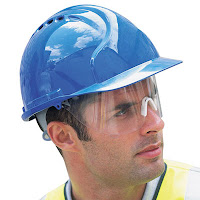
When one talks about head protection, we instantly think about the safety helmet. But people are often unaware of the significance of the helmet. For this very reason, construction workers and employees ought to enroll themselves in the OSHA 30 Hour Construction Course, in order to get a better understanding of the importance of PPE.
Firstly, this course is important, for it touches upon the areas in which the safety helmet ought to be worn. They are:
1.When there is a possibility that a person may be struck on the head by a falling object;
2.If a person is likely to strike his/her head against a fixed object; or
3.When there is a chance that an inadvertent head contact may be made with electrical hazards.
Here too, one must keep in mind that,'bump caps', the commonly used alternative of the safety helmet, does not always provide protection against any of the hazards, described above.
Fortunately, a wide range of accessories can be attached to the basic safety helmet, in order to make it suitable for variable working conditions. For example:
1.A retaining strap worn under the chin;
2.A cable clip and a bracket for the attachment of a lamp;
3.An eye shield, for welding;
4.A wide brim for additional shade;
5.Neck flaps for protection against weather;
6.A lining for cold conditions.
Here too, the OSHA 30 Hour Construction Course, highlights the fact that, one must at all times ensure that the attachment systems and accessories do not reduce the safety and effectiveness of the helmet. Particular care should be taken when electrical hazards are present.
While choosing a particular type of safety helmet, the following points must be taken into consideration:
1.Location and nature of the work;
2.Extent of adjustment for comfort.;
3.Accessories must be compatible with the make of the safety helmet that is being used;
It is here thats the OSHA 30 Hour Construction Courses highlights a very significant point that, 'white helmets,' often provide better heat reflection, but most importantly, they can be easily seen in poor lighting conditions.
With regards to the cleaning and maintenance of the safety helmet, it is always advisable to clean them on a regular basis. Try using normal washing ingredients, such as soap and warm water. The use of very hot water, solvents or harsh abrasives can reduce the effectiveness of the Hard hat or the safety helmet.
For further details contact: http://www.osha30hoursafetycourse.com/
Firstly, this course is important, for it touches upon the areas in which the safety helmet ought to be worn. They are:
1.When there is a possibility that a person may be struck on the head by a falling object;
2.If a person is likely to strike his/her head against a fixed object; or
3.When there is a chance that an inadvertent head contact may be made with electrical hazards.
Here too, one must keep in mind that,'bump caps', the commonly used alternative of the safety helmet, does not always provide protection against any of the hazards, described above.
Fortunately, a wide range of accessories can be attached to the basic safety helmet, in order to make it suitable for variable working conditions. For example:
1.A retaining strap worn under the chin;
2.A cable clip and a bracket for the attachment of a lamp;
3.An eye shield, for welding;
4.A wide brim for additional shade;
5.Neck flaps for protection against weather;
6.A lining for cold conditions.
Here too, the OSHA 30 Hour Construction Course, highlights the fact that, one must at all times ensure that the attachment systems and accessories do not reduce the safety and effectiveness of the helmet. Particular care should be taken when electrical hazards are present.
While choosing a particular type of safety helmet, the following points must be taken into consideration:
1.Location and nature of the work;
2.Extent of adjustment for comfort.;
3.Accessories must be compatible with the make of the safety helmet that is being used;
It is here thats the OSHA 30 Hour Construction Courses highlights a very significant point that, 'white helmets,' often provide better heat reflection, but most importantly, they can be easily seen in poor lighting conditions.
With regards to the cleaning and maintenance of the safety helmet, it is always advisable to clean them on a regular basis. Try using normal washing ingredients, such as soap and warm water. The use of very hot water, solvents or harsh abrasives can reduce the effectiveness of the Hard hat or the safety helmet.
For further details contact: http://www.osha30hoursafetycourse.com/
Comments
Post a Comment